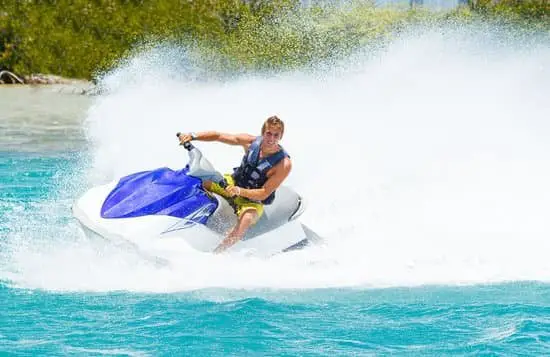There are few experiences as thrilling as riding a jet ski, even if all you know how to do is glide. Gliding at high speeds over the water’s surface is very exciting. But did you know there are many more things that you can do to add more thrill to your jet ski ride?
You can perform tricks on a jet ski. Not only does that feel amazing, but looks impressive to anybody watching. Professionals can do multiple consecutive backflips, and you might think that you will never be able to do that.
However, everyone starts from somewhere. You can begin your journey with these eight simple tricks that we have consolidated in this article.
First Things First
Even though we have got you excited, you must slow down and note a few things before you start jet skiing. You will not get permission to ski on the water in most places if you do not have a boating license.
It is a good idea to take some boating classes. It ensures that you have the necessary knowledge and skills required to be on the water on a motor vehicle.
Safety
Boating and skiing classes will help you understand the safe skills of being on top of a water motor vehicle. Classes will also teach you the basics of jet ski works and the correct, safe operation. Your safety should be your priority every time you get on the water.
Regulations
You must also be aware of the laws of the area in which you are riding. Different places have different regulations on speeding limits and duration. These laws exist for a reason, and you must be aware of them and strictly abide by them.
Type of Jet Ski
There are different kinds of jet skis, and before you start riding one, you must know about it. The performability of jet ski tricks depends on whether you are riding a sit-down model or a stand-up model.
While a handful of tricks can get performed on both types, a few require a specific kind of jet ski to get executed.
Emergency Situations
Taking a class will help you understand how you deal with a wipeout. Much like any other sport or activity, jet skiing is also subject to mistakes. However, you must know how to overcome these mistakes instead of putting yourself at risk quickly.
It would be best if you learned how to mitigate an event in which you might get thrown off your jet ski.
Things You Can Do If You Fall Off a Jet Ski
Re-mounting the ski can be straightforward if it has landed with the right side up. It is because jet skis have lanyards that are attached to your body to keep you from getting lost at sea if you fall in the water.
Just like a treadmill’s safety lanyard, the jet ski will automatically shut off in a situation like this.
You will require to flip over the jet ski if it falls upside down. It needs to be done quickly since the engine’s watertight seals, and the storage might start to give away after a little time. It might cause severe damage to the machinery.
Even though flipping a jet ski is simple, it is good to practice doing it not to freeze in an emergency.
The basic technique of flipping over a jet ski involves you stepping onto one side of the jet ski. Your body must be on top of one side so that you can hold the other side of the deck. You must push down with your legs and pull towards your body simultaneously.
However, you must be careful not to get caught underneath the jet ski.
Most manufacturers have a direction in which they recommend flipping a jet ski. Be sure always to follow that direction. Executing this technique can get complicated if you are in deep water and cannot reach the bottom. However, with proper practice, you will be able to do it.
Simple Jet Ski Tricks
Now that you are aware of pre-jet ski mounting measures, we get into the exciting stuff. Below are eight simple tricks that you can perform to get the extra kick of adrenaline and impress your friends.
Accelerating and Stopping
Accelerating and stopping are essential skills that you require while jet skiing. While you may learn about them in the beginners’ class, you will have to practice to master them. All the other tricks you will learn in this article require you to know how to accelerate and stop a jet ski correctly.
Most jet ski engines have relatively powerful motors. They can accelerate from 0 to 30 miles within 2 seconds. Therefore, accelerating can be a tricky and sometimes dangerous thing to do. It would be best if you rode for the first few hours, getting used to the jet ski speed and acceleration.
You will consequently be able to adjust to comfortable hand positions, body posture, and overall balance condition.
Initial practice will also get you accustomed to the throttle positions. Therefore, you will not have to look at the speedometer to understand your speed frequently.
The throttle engagement would be enough to let you know about your riding speed. With this ability, you will have less distraction and more focus on executing the trick you will attempt.
Once you are accustomed to the throttle, stopping also becomes more comfortable. Stopping means letting go of the throttle since only a few jet ski models have actual brakes to stop or slow down.
Therefore, either easing or letting go of the throttle is the way to slow or stop a traditional jet ski.
Practicing the easing or letting go of the throttle is crucial as well. Losing speed out of the blue can make you drop into the blue. You can lose balance and fall into the water.
It is a crucial thing to master since most tricks require you to slow down the jet ski just a little bit before while performing them. This speed reduction is necessary to maintain the safety and control that you will have while performing them.
Riding While Standing
Akin to accelerating and stopping, riding while standing may come across as a simple trick to perform. However, just like it, this is a technique that you need to learn and master properly by practicing.
If you have been practicing on a stand-up jet ski, then you have nothing to learn; you have been standing on the jet ski from your first ride onward. However, while using a sit-down jet ski, you will have to practice for hours before you attempt this trick.
To ride while standing is crucial to master because most tricks require you to be out of your seats. The process is very different from riding while sitting down. It requires a lot more muscle work as your upper body, core, legs, knees, ankles, and feet provide stability.
While learning how to ride while standing, you will need time to get familiar with the jet ski’s increasing and decreasing speed. You will also need to get used to how the ski feels on rough or smooth waters.
With enough practice, you will figure out the right position that works for you. You will be able to hold your body for optimum balance and bend your knees for perfect responsiveness.
Only attempt the next tricks if you are comfortable riding while standing at high speeds and can effortlessly turn the ski without losing composure and balance.
Carving
Carving is nothing but making an extremely sharp turn on the surface of the water. It is an essential trick that helps the user maintain control over the jet ski. Carving gets used in sports such as skiing and snowboarding.
Carving can be crucial at a time to skip obstacles and perform advanced tricks. However, carving is much more than turning the handlebars in a particular direction. There is much more to it; otherwise, you will risk falling off the ski.
You need to lean your whole body towards the direction in which you want to carve. It would be best if you learned the optimum angle at which you will have to lean.
If you lean too much or too little, you will be off the jet ski in no time. Therefore, leaning is the most significant factor that influences the process of carving.
An important thing to note here is that you will have to ease the throttle a bit while making a sharp turn. If you completely stop the jet ski, you will get pushed in an unwanted direction due to the initial velocity.
It would be best if you progressed slowly while carving. Do not pressure yourself into flipping all the way on your very first attempt. You can bend a little and gradually head into a complete leaning direction. Make sure that you have a suitable training area.
You must have enough space to move forward and go in any direction that you want. It is also necessary to have no people around for general safety.
Circles
While jet skiing, making circles in the water is an extremely intriguing trick to perform. Making circles is crucial to make a single wide turn, which can come in handy when you are trying to get away from waves. Many tricks require working with waves and knowing how to make circles with a jet ski.
When trying to get away from waves, you will need to make broad and full turns. To create circles, all you need to do is turn your handlebars in the direction that you want to lean in. Just like carves, they require small steps to practice.
Don’t be in a hurry to make perfect circles. Only make circles in a way that you are fluent with the process.
Only go in circles when you are comfortable and see how wide an angle feels easy to you. Once you are compatible with riding in circles, you can shift to turning in sharper angles.
Donuts
Donuts are extremely fun to learn. Making donuts is a dizzying trick that is sure to give you an adrenaline rush. Making donuts on a jet ski is similar to making donuts in a car. You won’t be going anywhere; all you will be doing is rotating in one place.
The technique of making donuts is as easy as it gets. The only thing you have to practice is maintaining your balance when the tricks’ primary purpose is to make you dizzy.
How you place your feet is crucial to this trick since wrong placement can lead to the front of your jet ski to be dipping inside water. Standing towards the back will also prevent the bow of the ski from going under the surface. This foot placement is something that you’ll have to get used to with time.
To make donuts, you have to be in control of the handlebars. You need to be able to turn the direction either way. You will have to lean heavily towards a single angle and make the most out of your weight. It requires balance and stability.
Practicing is crucial to ensure that your jet ski does not dip into the water entirely, making you go off balance. You must also practice, ensuring that the donuts get created flawlessly, without them looking like crooked circles.
You will have to bring the opposite leg over the seat to the direction in which you are turning if you are using a sit-down jet ski model.
It will pull your entire weight on one side and result in a sharper donut that has a small radius. However, this is an advanced technique that must only get attempted if you are entirely secure in your balance and stability.
Driving Over Wake
A wonderful thing about jet skiing is that you can perform tricks not only on water but also in the air. It is the wake that is created by boats or jet skis that allow you to perform tricks over the surface of the water.
Riding over the wake is not as simple as riding over a smooth surface of after. However, it is the first step to learn how to jump with a jet ski.
Practicing how to drive the wake is easy if you are riding with some friends and have multiple jet skis. All you need to do is ride perpendicular towards the water wake that their skis create.
However, it would be perfect if you kept your distance since collisions are hazardous. If you are practicing alone, you can use your own wake that you create while making circles.
Since you need to learn how to ride over the wake and not through it, you will have to learn how to lean backward. Leaning backward will allow you to have the bow of the jet ski pointing upward, which will help you go over the wake.
In case you are going to face some height difference, you will have to make sure that the legs are loose enough to adjust variations. However, they must be firm enough to ensure that the body gets supported efficiently on your legs. Your knees should be stiff and in the proper position if you want to not slip off the jet ski.
Jumping the Wake
The next step to master after you have learned how to drive over a wake is to jump over it. While the two tricks are almost similar, the latter requires more aggressive body and motor action.
When you are approaching the wake that you want to jump over, juice up the engine. Then, lean back more aggressively to give the jet ski motion to go higher into the air.
While jumping over the wake is relatively simple when you already know how to drive over it, it is the landing that requires attention. While landing, your body needs to be loose so that it is responsive to a change in pressure and direction. If you impact with a stiff body, you come at a risk of sustaining spine injuries.
Your knees should be bent at an appropriate level and be the only part of your body that are stiff. They work as the angling point while the legs are ready to expand and contract according to the change in height.
Surface 180
It would be best if you were a master of all the above tricks to attempt doing the surface 180. This trick takes the simple carving trick and adds another level to it. It seems to be a relatively easy trick once you get the hang of it, however.
To perform surface 180, you will have to maintain medium speed while the handlebars get turned towards one direction. You will then have to quickly turn the handlebars to the extreme opposite side while fully engaging the throttle. However, make sure that most of your weight gets focused on the side towards which you are turning. Also, leaning at the back while you change the direction.
Performing a surface 180 ensures that you completely turn right at the spot where you decided to perform the trick. It is a highly effective and advanced trick that requires confidence and balance. Make sure that you have enough practice on carving before performing this trick.
Endnotes
Practice makes a man perfect. This principle applies diligently to the tricks explained above. You will probably not be able to nail the tricks on your first attempt and will need assistance. However, after a few hours or days of practice, you will be able to master each of these tricks effortlessly.
First, remember that your safety is the most important thing. Therefore, if you feel uncomfortable or underconfident while performing a trick, do not try to do it. You can leave it for later or practice gradually to reach the point where you feel comfortable.
The point of learning these tricks is to be safe and have fun. You don’t want to injure yourself while learning something cool. Therefore, take it easy when required and enjoy the progress you make every time you practice.






